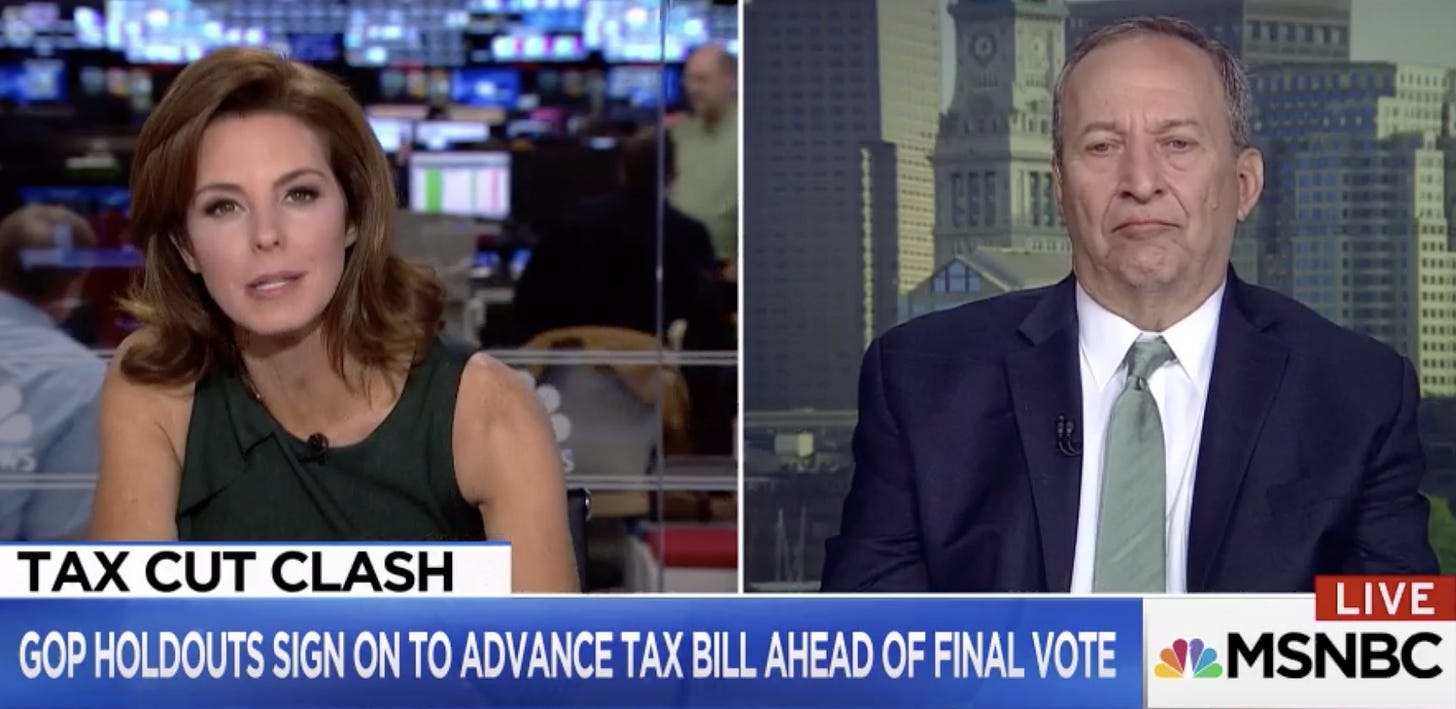Almost exactly two years before the pandemic began, I wrote that we should use fiscal policy to fight the next recession. I wasn’t predicting a downturn—and I certainly didn’t see COVID-19 coming—but I knew that something would eventually slow the pace of economic growth and push the economy into recession. I wrote the piece because I was worried that policymakers might actually believe what people like Larry Summers (and others) were saying at the time.
Back then, Summers was raging against the GOP tax plan.1 He was everywhere—as he is now—opining on the impacts of proposed legislation. In addition to making another run at overturning the Affordable Care Act, Republicans were on the verge of passing their sweeping tax cuts. In a last-ditch effort to undermine support for the Tax Cuts and Jobs Act (TCJA), Summers took his case to the American people, penning numerous op-Eds and appearing in countless interviews.
His predictions were both specific and dire.
He warned that passage of the TCJA would mean that “our country will be living on a shoestring for decades to come because of the increases in the deficit that will result.” He called it “a serious threat to our national security because of what it will mean over time for our ability to fund national defense.” And he predicted that it would leave Congress with “less room” to “repair infrastructure” or to “respond” if the “economy slows down.”
Oops!
Within weeks of the above interview, Republicans passed the Tax Cuts and Jobs Act, adding an estimated $1.9 trillion to the deficit. According to Summers, that should have raised the drawbridge on fiscal spending, sealing off any chance to defeat potential enemies at the gate for decades to come.
It obviously did no such thing.
When the pandemic hit in early 2020, Congress quickly delivered a robust $2.2 trillion fiscal package, known as the CARES Act. That bill was signed into law by President Trump on March 27, 2020. Then, in December 2020, lawmakers returned with more fiscal support, passing a $900B consolidated appropriations bill to shore up the economic recovery. A few months later, in March 2021, President Biden signed the $1.9 trillion American Rescue Plan (ARP). What this means is that Congress kicked out ~$5 trillion in roughly one year’s time. And virtually every penny added to the deficit.
That is some “shoestring”! 😉
The point is that passage of the Trump tax cuts in December 2017 did absolutely nothing to constrain the spending capacity of the federal government in 2020. Not only did Congress have all the firepower it needed to respond to the slowdown, it had the fiscal fortitude to reverse the downturn in record time. Specifically, the National Bureau of Economic Research (NBER) found that the US economy escaped the COVID-induced recession after just two months. The shortest recession in US history.
But the story doesn’t end there. Just a few days ago, President Biden signed the $1.2 trillion bipartisan infrastructure (BIF) package, which includes $550 billion in new spending. And then, yesterday, the House passed the nearly $2 trillion Build Back Better Act (BBB). And while each of these bills is partially “paid for,” the Congressional Budget Office (CBO) estimates that they would add a combined $416 billion to the deficit over time ($256 billion from BIF and $160 billion from BBB).
Happening alongside all of this, the Senate is preparing to vote on the annual defense budget. So perhaps this is where the “shoestring” comes into play? We’ve increased the deficit by another $6 trillion or so since Summers warned that the run up in the deficit would hamper “our ability to fund our national defense.” And yet far from leaving lawmakers with “less room” to fund the military—as Summers predicted—Congress is on the verge of authorizing some $778 billion in defense spending, an allocation that would exceed President Trump’s last defense budget by $37 billion while providing $25 billion more than President Biden had requested.
So, we beat a recession in record time. We’re making the biggest ever one-time investment in our nation’s infrastructure. And the Department of Defense (DoD) is set to receive an even bigger annual appropriation.
How anyone—least of all a former Secretary of the US Treasury—could have predicted that adding to the deficit in 2017 would somehow jeopardize any of this is beyond me.
Today, of course, Summers has shifted from complaining about deficits, per se, to complaining about “overheating.” Specifically, he (and others) have argued that the size ($1.9 trillion) and scope (especially the $1,400 checks and the $300/week federal unemployment insurance) of the March 2021 package, put too much money into too many hands, triggering the elevated inflation rates we’re experiencing today.
The Federal Reserve Bank of San Francisco disagrees, as does former Fed economist Claudia Sahm, who follows this stuff as closely as anyone I know. So do scores of other economists and financial market practitioners. And so do I.
Last week, I spoke at length about what I see as the main drivers of our current bout of higher-than-normal inflation. Here are links to two of those appearances.
Over the weekend, I’ll be working on a longer piece about inflation—from an MMT lens—for The Atlantic. In the meantime, I recommend reading more Sahm and less Summers.






Summers is a neo-liberal idiot, and I completely agree with MMT that fiscal deficits are virtually entirely irrelevant. What I don't get is why MMTers don't have their hair on fire for a 50% discount/rebate policy at the point of retail sale which would immediately double everyone's purchasing power, integrate beneficial price and asset DEFLATION into profit making economic systems and which policy in doubling potential demand politically unites labor and management against Finance and isolates them by exposing their monopolistic paradigm of Debt Only. I want progress, but I'd love to have paradigm change a lot more.